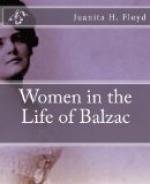Soon after Balzac met Madame Hanska, he reserved for her the original of an epistle from Madame Desbordes-Valmore which he regarded as a masterpiece. Balzac’s friendship for the poetess, which began so early in his literary life, was a permanent one. Just before leaving for his prolonged visit in Russia, he wrote her a most complimentary letter in which he expressed his hopes of being of service to M. Valmore at the Comedie Francaise, and bade her good-bye, wishing her and her family much happiness.
Madame Desbordes-Valmore was one of the three women whom Balzac used as a model in portraying some of the traits of his noted character, Cousin Bette. He made Douai, her native place, the setting of La Recherche de l’Absolu, and dedicated to her in 1845 one of his early stories, Jesus-Christ en Flandres:
“To Marceline Desbordes-Valmore,
“To you, daughter of Flanders,
who are one of its modern glories, I
dedicate this naive tradition of old Flanders.
“DE BALZAC.”
Though Balzac’s first play, and first attempt in literature, Cromwell, was a complete failure, this did not deter him from longing to become a successful playwright. After having established himself as a novelist, he turned again to this field of literature. Having written several plays, he was acquainted, naturally, with the leading actresses of his day; among these was Madame Dorval, whom he liked. He purposed giving her the main role in Les Ressources de Quinola, but when he assembled the artists to hear his play, he had not finished it, and improvised the fifth act so badly that Madame Dorval left the room, refusing to accept her part.
Again, he wished her to take the leading role in La Maratre (as the play was called after she had objected to the name, Gertrude, Tragedie bourgeoise). To their disappointment, however, the theater director, Hostein, gave the heroine’s part to Madame Lacressoniere; the tragedy was produced in 1848. The following year, while in Russia, Balzac sketched another play in which Madame Dorval was to have the leading role, but she died a few weeks later.
Mademoiselle Georges was asked to take the role of Brancadori in Les Ressources de Quinola, presented for the first time on March 19, 1842, at the Odeon.
Balzac was acquainted with Mademoiselle Mars also, and was careful to preserve her autograph in order to send it to his “Polar Star,” when the actress wrote to him about her role in La grande Mademoiselle.
LA DUCHESSE D’ABRANTES
“She has ended like the Empire.”
Another of Balzac’s literary friends was Madame Laure Junot, the Duchesse d’Abrantes. She was an intimate friend of Madame de Girardin and it was in the salon of the latter’s mother, Madame Sophie Gay, that Balzac met her.




